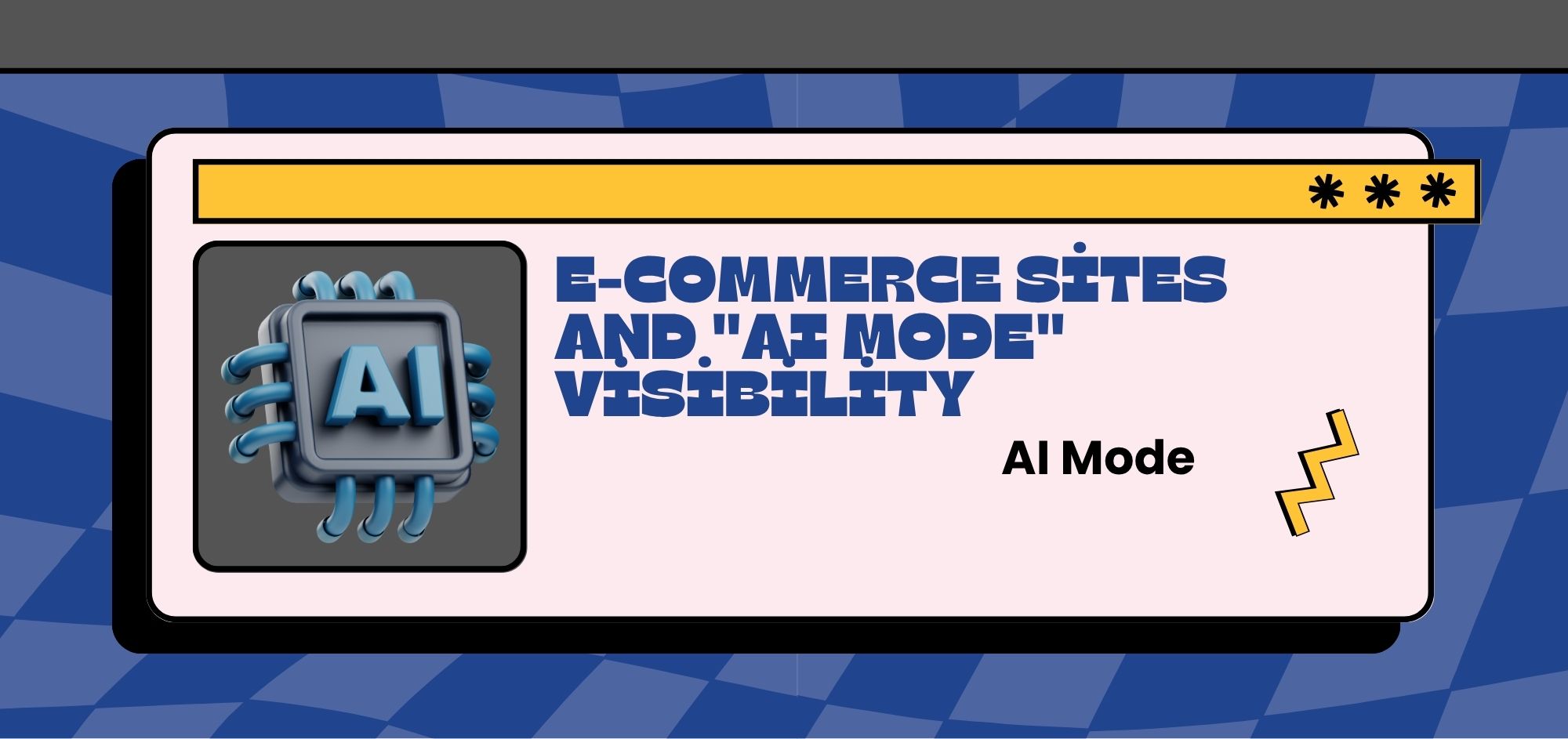
Beyza Aras
Jun 4, 2025E-Commerce Sites and "AI Mode" Visibility

E-Commerce Sites and "AI Mode" Visibility
E-commerce sites are undergoing a transformation with AI-powered "AI Mode" technologies, offering critical opportunities for brands aiming to stand out in visibility and competition. Simply listing products is no longer enough; how the site interacts with users and what it offers to algorithms has become much more important.
"AI Mode" is a next-generation approach in e-commerce that personalizes user experience, provides data-driven recommendations, and helps achieve better rankings in search engines. In an environment where search engines like Google prioritize advanced AI-based systems, adopting the right strategies is essential to gain visibility.
What is AI Mode and Why is it Important for E-Commerce Sites?
AI Mode, or Artificial Intelligence Mode, is a technology suite in e-commerce that analyzes user behavior to deliver personalized content, product recommendations, and shopping experiences. From the moment users enter the site, they encounter customized products, campaigns, and interfaces. This leads to:
- Increased user satisfaction
- Higher cart creation rates
- Shortened shopping time
For example, an e-commerce site using AI Mode can customize its homepage based on the visitor’s previous shopping data, achieving up to a 30% increase in cart creation rates.
Additionally, AI Mode is not just a sales booster; it plays a vital role in SEO. Search engines determine page value based on user interactions. Content enriched with AI Mode helps to:
- Reduce bounce rates
- Increase page engagement
- Improve Google rankings
The Impact of AI Mode on SEO in E-Commerce
AI Mode stands out in SEO by enhancing page experience based on user behavior. Google’s emphasis on user-focused metrics like Core Web Vitals makes investing in this area crucial for e-commerce sites. For instance, with AI Mode:
- Product pages can load faster
- Users find desired products quicker
- Personalized suggestions in search boxes can reduce bounce rates by 20-35%
- All these factors directly affect SEO performance.
Moreover, e-commerce sites using AI Mode generate richer data. This data helps restructure content and optimize pages with more relevant keywords. For example, the system can automatically identify the most searched keywords by users and incorporate them into titles and descriptions to boost organic traffic. Terms like “AI-driven SEO,” “AI-powered search optimization,” and “AI-supported SEO strategies” fit well with this content.
The Evolution of Product Recommendation Systems with AI Mode
Traditional product recommendation systems usually operate on fixed rules and past sales data. However, AI Mode technology has transformed these systems into dynamic, real-time, behavior-driven models. For example, when a user visits a site for the second time, AI Mode analyzes their previous browsing behavior and places relevant products on the homepage. This significantly boosts revenue, especially through strategies such as cross-selling and upselling.
Traditional product recommendation systems often rely on static rules and sales history. But with AI Mode, these systems become dynamic and behavior-focused in real time. Users now encounter personalized products based on their past preferences whenever they revisit the site. This facilitates strategies like:
- Cross-selling
- Upselling
and leads to increased revenue. To illustrate with numbers:
| System Type | Click-Through Rate Increase | Increase Conversion |
| Traditional Recommendation Systems | 10-15% | 5-10% |
| AI Mode Supported Systems | up to 60% | Up to 35% |
Advanced recommendation systems using AI Mode can provide up to 60% higher click-through rates and up to 35% higher conversion rates compared to traditional systems. You can also use keywords with high search potential such as “personalized recommendation systems” and “product recommendation with artificial intelligence in e-commerce” within this title. Such systems have become applicable not only to large e-commerce giants; but also to small and medium-sized sites. Integrated AI tools are rapidly spreading, especially on platforms such as Shopify and WooCommerce.
User Experience and AI Mode Integration in E-Commerce Sites
User experience (UX) is one of the key factors determining the success of an e-commerce site. AI Mode transforms an ordinary shopping experience into an unforgettable journey by customizing this experience for the individual user. For example, when a visitor is searching for sneakers, they may encounter not only the price filter, but also additional filters such as “comfort level” or “purpose of use” based on their previous preferences. This shortens the decision-making process and saves the user time. This micro-customization offered by AI Mode keeps the user on the site longer and increases the view rate per page.
This dynamic structure, which contributes to UX, also has a positive effect on SEO. Search engines like Google rank by taking into account the time users spend on a site and the level of interaction on the site. Thanks to the AI-supported user experience, an e-commerce site becomes more valuable both in the eyes of users and in search engines. Searches such as “UX design with AI” and “AI solutions that increase user experience” can also be targeted under this heading. Visual optimization, smart chatbots and behavior-based notification systems can also be evaluated within this scope.
Ways to Increase Conversion Rates in E-Commerce with AI Mode
The conversion rate is one of the most critical indicators of the success of an e-commerce site. AI Mode increases this rate by getting to know users better and offering them special offers and experiences. For example, when a user adds a product to their cart, AI Mode shows similar products in real time and triggers the purchase decision with messages like “you may also like this”. Similarly, personalized email campaigns or instant discount offers can be offered for abandoned carts. Up to 25% increase in conversion rate can be observed with these strategies.
In addition, thanks to A/B tests supported by artificial intelligence, it is possible to automatically analyze which campaign messages, banners or CTA (call-to-action) buttons provide more interaction. These automations produce results 50% faster than manual tests. Terms such as “AI-supported conversion increase tactics”, “ways to increase sales in e-commerce”, “customer behavior analysis with AI” can also be evaluated within the content compatibility with this title. When success examples are examined, it is seen that the return on investment (ROI) of companies working with AI Mode is 30% higher on average.
How to Integrate AI Mode for E-Commerce Sites?
Integration of AI Mode into e-commerce sites is possible with the right tool selection and a solid data structure. As a first step, the current infrastructure of the site should be analyzed and how user data is collected should be evaluated. This data enables AI systems to learn. Then, AI software (e.g. recommendation engines, chatbots, dynamic pricing systems) that are suitable for the needs should be determined and integrated. These tools are usually connected to the site via API. Ready-made integrations are available for platforms such as Shopify, Magento, and WooCommerce.
Another issue that is as important as technical integration is continuous optimization. The performance of AI systems should be analyzed regularly, and models should be updated in light of incoming data. This allows for better responses to user behavior over time. In addition, data security laws such as GDPR should be taken into consideration during integration. Search terms such as “How is artificial intelligence integrated?”, “How are AI systems integrated into e-commerce infrastructure?” can also be included in this title. Improvements in conversion increase, visitor satisfaction, and SEO metrics after integration can be easily observed.
More resources

ChatGPT Shopping Research: An AI-Powered Shopping Assistant
ChatGPT Shopping Research is an AI-powered shopping assistant that accelerates users' shopping resea...

Data-Driven Tactics to Build Customer Loyalty After Black Friday
Customer loyalty is the most valuable outcome of the Black Friday period, as short-term traffic and...

5 Ways to Measure Sales Uplift Accurately with Google MMM
5 Ways to Measure Sales Uplift Accurately with Google MMMGoogle MMM (Marketing Mix Modeling) is one...

